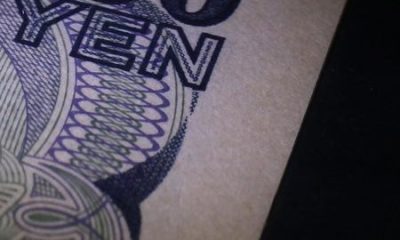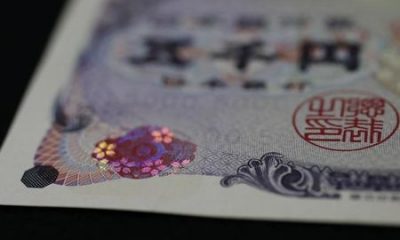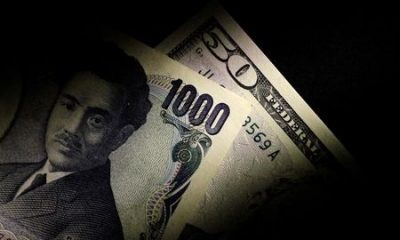Forex
Dollar flat ahead of key inflation release; Middle East tensions ease
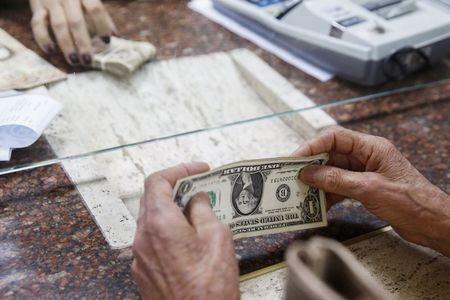
Investing.com – The U.S. dollar traded largely unchanged in calm trading Monday, amid a calming of tensions in the Middle East and ahead of the release of the Federal Reserve’s favorite gauge of inflation later in the week.
At 05:40 ET (09:40 GMT), the Dollar Index, which tracks the greenback against a basket of six other currencies, traded flat at 106.005, retreating from the five-month peak of 106.51 seen last week.
Dollar stable ahead of key inflation release
The dollar surged to new highs last week after Israel launched a missile attack on Iran, in an escalation of the conflict in the volatile Middle East.
However, tensions appear to have been cooled, with Tehran downplaying Israel’s retaliatory drone strike against Iran, in what appeared to be a move aimed at averting a regional war.
“Sentiment is generally supported across asset classes as the week starts,” said analysts at ING, in a note. “All interested parties appear to have chosen the path of downplaying the size and consequences of Friday’s Israeli strikes in Iran.”
That said, the dollar has also been supported by strong U.S. economic data and persistent inflation, coupled with a slew of hawkish comments from Fed officials, reducing the chances of the Federal Reserve cutting rates any time soon.
These officials will be keeping quiet this week, ahead of next week’s , but activity is likely to be limited ahead of Friday’s look at the , the Federal Reserve’s favored inflation gauge, which economists expect to remain elevated in March.
remove ads
.
Other economic data for the week includes an initial estimate of first quarter , which is expected to have moderated slightly from the previous quarter. Data on and will also be released along with revised figures on consumer sentiment and inflation expectations.
Euro edges up, but ECB set to cut early
In Europe, rose 0.1% to 1.0656, trading near six-month lows with regional economic weakness set to result in the European Central Bank cutting interest rates before the Federal Reserve.
Elevated tensions in the Middle East are unlikely to drive up energy prices and should not affect the European Central Bank’s plans to start cutting interest rates in June, French central bank chief Francois Villeroy de Galhau said on Sunday.
“Barring surprises, there is no need to wait much longer”, Villeroy told business daily Les Echos in an interview. “At the moment, the conflict is not leading to a marked rise in oil prices. If this were ever the case, we would have to analyse monetary policy for whether this shock is temporary and limited, or whether it is transmitted – beyond commodities – to underlying inflation.”
climbed 0.1% lower to 1.2355, just above its lowest level since mid-November seen on Friday, after Bank of England Governor Andrew Bailey and Deputy Governor Dave Ramsden alluded last week to Britain’s inflation slowing as expected.
“Sterling markets moved on Friday after the Bank of England’s deputy governor, Dave Ramsden, sounded less concerned about price pressures and suggested that there were indications of UK inflation converging to that of the eurozone,” ING said. “Crucially, he added that the Bank will be “responsive” as evidence on inflation accumulates.”
remove ads
.
Yen weak ahead of BOJ meeting
In Asia, traded 0.1% higher at 154.74, remaining well above the 154 level and near 34-year highs, keeping investors on guard over any potential government intervention.
Focus this week is on a Bank of Japan rate decision on Friday – the central bank’s first meeting after a historic rate hike in March. Any cues on future rate hikes and policy changes will be closely watched.
edged 0.1% higher to 7.2437, after the People’s Bank of China kept its benchmark on hold, as expected.
The LPR was kept at record lows, as the PBOC moved to keep monetary policy as loose as possible to buoy economic growth. However, low interest rates are also expected to keep the yuan under pressure.
The USDCNY pair was close to a five-month high, above the psychologically important 7.2 level.
Forex
Asia FX on guard before payrolls data, yen rebounds amid likely intervention
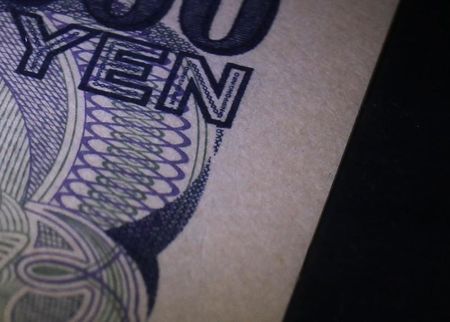
Investing.com– Most Asian currencies rose slightly on Friday, capitalizing on a drop in the dollar as markets hunkered down before key U.S. payrolls data that is likely to factor into interest rates.
The dollar was also pressured by a rebound in the Japanese yen, which pulled further away from 34-year lows amid what appeared to be government intervention in currency markets.
Weakness in the dollar offered some breathing room to regional currencies, although they were still nursing steep losses on the prospect of U.S. interest rates remaining high for longer.
Japanese yen firms amid likely intervention, USDJPY at 3-week low
The Japanese yen saw extended gains on Friday, with the pair- which moves inversely to strength in the yen- falling 0.4% to 153.02. The pair briefly hit a three-week low of 152.9.
The USDJPY pair was set to lose about 3.4% this week as it tumbled from 34-year highs. Traders and analysts attributed the drop largely to currency market intervention by the Japanese government.
The USDJPY pair had surged to 160 earlier this week. Traders said this level was the new line in the sand for currency market intervention.
Domestic Japanese markets were closed on Friday. But the lower volumes also aided the yen.
Still, the factors that had spurred recent yen weakness remained in play, chiefly the prospect of high-for-longer U.S. interest rates.
Broader Asian currencies rose slightly, capitalizing on an overnight drop in the dollar. The Australian dollar’s pair rose 0.2%, as markets positioned for potentially hawkish signals from the next week. Hotter-than-expected Australian inflation readings saw markets largely price out expectations of any rate cuts by the RBA in 2024, offering the Aussie some strength.
remove ads
.
Trading volumes in Asia remained muted on account of market holidays in Japan and China.
The South Korean won’s pair fell 0.3%, while the Singapore dollar’s pair fell 0.1%.
The Indian rupee’s pair fell slightly, and was trading well below record highs hit in April.
Dollar steadies from overnight losses, nonfarm payrolls awaited
The and steadied in Asian trade after tumbling in overnight trade, as pressure from the yen and expectations of no more interest rate hikes by the Federal Reserve dented the greenback.
Focus was now squarely on data for April, which is due later in the day. The reading has consistently beaten estimates for the past five months, with any signs of persistent labor market strength giving the Fed more headroom to keep rates high for longer.
The Fed signaled earlier this week that it had no plans to cut rates in the near-term, especially in the face of sticky inflation.
Forex
Japanese yen rises, USDJPY hits 3-week low on suspected intervention
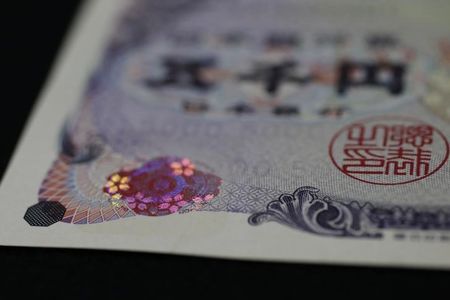
Investing.com– The Japanese yen firmed on Friday, with the USDJPY pair hitting a three-week low after sharp declines through this week that traders largely attributed to government intervention.
The pair, which gauges the amount of yen required to buy one dollar, was trading down 0.2% at 153.34 yen. It had fallen as low as 152.9 on Thursday, reaching its weakest level since mid-April.
The USDJPY pair fell sharply through this week amid increasing evidence that the Japanese government had intervened in markets on at least three separate instances- on Monday, Wednesday and Thursday.
The suspected intervention came after the USDJPY pair surged to 160 at the beginning of the week, which traders said was the new line in the sand for the yen. The Japanese currency started the week at its weakest level since 1990.
The factors that had pressured the yen in the lead-up to this week still remained in play. Recent comments from the U.S. Federal Reserve reinforced expectations that interest rates will remain high for longer.
A widening gap between U.S. and Japanese rates was a key point of pressure on the yen, with a historic rate hike by the Bank of Japan in March doing little to alleviate this pressure.
The BOJ also offered middling signals on future rate hikes during a late-April meeting, which triggered the yen’s recent bout of losses.
While Japanese government officials did not directly confirm this week’s intervention, Reuters estimated that Japan may have spent between 3.66 trillion yen and 5.5 trillion yen ($23.59 billion- $35.06 billion) when intervening in markets on Monday, based on BOJ data.
remove ads
.
Forex
Yen higher after suspected intervention
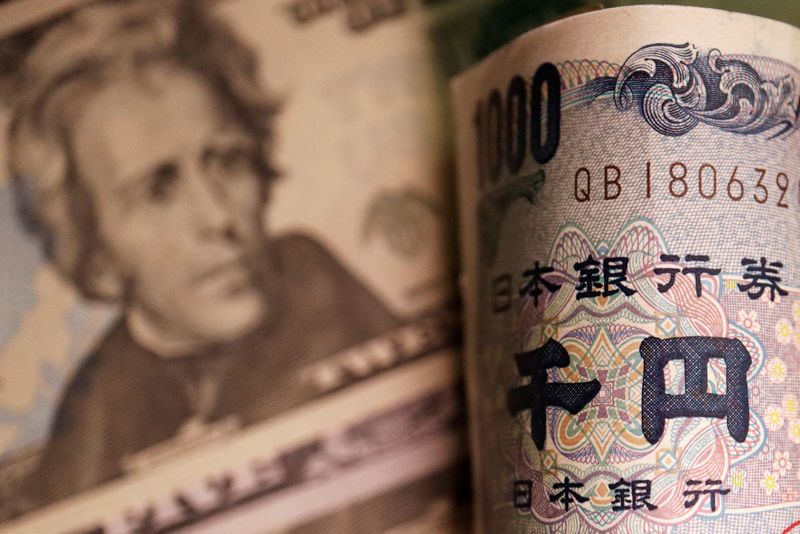
By Karen Brettell
NEW YORK (Reuters) – The yen gained on Thursday, following a sudden rally late on Wednesday that traders and analysts attributed to intervention by Japanese authorities, while the dollar was broadly lower before key jobs data on Friday.
The sharp move in the yen on Wednesday came in a quiet period for markets after Wall Street had closed, and hours after the U.S. Federal Reserve had wrapped up its policy meeting.
Fed Chair Jerome Powell confirmed the central bank’s expectation to cut rates, but acknowledged such a move would come later than expected due to stubbornly high inflation.
The dollar eased, however, due to the Fed not adopting a more hawkish tone that included the potential for further rate hikes.
The timing of the intervention was “pragmatic,” as “volumes were light, liquidity was thin, and it’s easier to make an impact at that time,” said Brad Bechtel, global head of FX at Jefferies in New York.
The dollar was last down 0.9% at 153.09 yen..
Japan’s vice finance minister for international affairs, Masato Kanda, who oversees currency policy at the Ministry of Finance, told Reuters he had no comment on whether Japan had intervened in the market.
Wednesday’s volatility came after a similar move on Monday, which was also during a time of light trading.
“Clearly they want to make as much as an impact and do it as efficiently as possible,” said Bechtel.
The Bank of Japan’s official data indicated Japan may have spent 3.66 trillion yen ($23.59 billion) on Wednesday and 5.5 trillion yen ($35.06 billion) supporting the currency on Monday to pull it back from new 34-year lows.
remove ads
.
While the supposed interventions may buy Japan some time, the trend is likely to remain negative for the Japanese currency until the U.S. economy slows and as long as the Bank of Japan disappoints traders on how far it is willing to raise rates.
The dollar remains up more than 10% against the yen this year, as traders push back expectations on the timing of a first Fed rate cut, while the BOJ has signaled it will go slow with further policy tightening after raising rates in March for the first time since 2007.
The next major U.S. economic focus that could drive further moves in dollar/yen will be Friday’s jobs report for April, which is expected to show that employers added 243,000 jobs during the month.
“A lot hinges on tomorrow’s jobs report,” said Marc Chandler, chief market strategist at Bannockburn Global Forex in New York.
A weaker number would give Japanese authorities relief, and likely pull Treasury yields and the dollar lower. A strong report, however, could send yields and the greenback higher and increase the risk of further interventions.
If 10-year Treasury yields approach the 5% region, “I’d say the dollar/yen is going to come under more pressure,” said Chandler. “It’s all about what happens with U.S. rates – we’re sort of the big moving piece.”
Benchmark 10-year Treasury yields were last at 4.57%.
Data on Thursday showed that the number of Americans filing new claims for unemployment benefits held steady at a low level last week.
remove ads
.
The fell 0.38% to 105.31, while the euro gained 0.17% to $1.0728.
The dollar weakened 0.59% to 0.91 Swiss francs after Swiss annual inflation in April accelerated faster than expected.
In cryptocurrencies, bitcoin gained 3.56% to $59,319.

 Forex2 years ago
Forex2 years agoForex Today: the dollar is gaining strength amid gloomy sentiment at the start of the Fed’s week

 Forex2 years ago
Forex2 years agoHow is the Australian dollar doing today?

 Forex1 year ago
Forex1 year agoUnbiased review of Pocket Option broker

 Forex2 years ago
Forex2 years agoDollar to pound sterling exchange rate today: Pound plummeted to its lowest since 1985

 Cryptocurrency2 years ago
Cryptocurrency2 years agoWhat happened in the crypto market – current events today

 World2 years ago
World2 years agoWhy are modern video games an art form?

 Stock Markets2 years ago
Stock Markets2 years agoMorgan Stanley: bear market rally to continue

 Economy2 years ago
Economy2 years agoCrude oil tankers double in price due to EU anti-Russian sanctions

